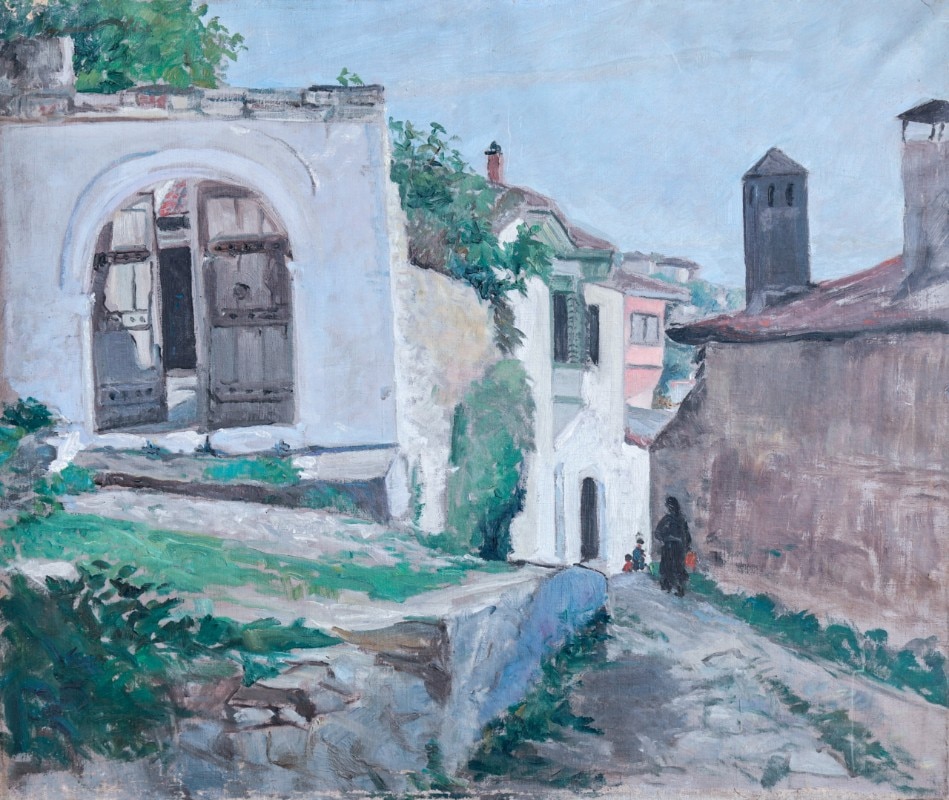Albania is currently experiencing political tension. On December 9th, the opposition Democratic Party of Albania, led by Lulzim Basha, turned to the country’s Constitutional Court to challenge the migrant agreement signed by Edi Rama and Giorgia Meloni. Frontex announces that it will not assist Italy in repatriations from Albania. The matter is complex.
In the European memory, Albania is often associated with migration, and it is hard to forget the largest migrant landing in Italy, which occurred on August 8th, 1991, in the port of Bari. It was a pivotal event in the rebellion of the Albanian people.
However, Albania is not just a country of migrants but a land rich in art and history, as vividly portrayed by the artist Vangjush Mio.
‘Poet of the Albanian Landscape.’ ‘The First and Only Albanian Impressionist.’ ‘Pioneer of Light and Painting.’ ‘Initiator of Modern Art in Albania.’
These are the various titles and accolades given to one of the most notable realist painters of the 20th century. Vangjush Mio was born in Korçë in 1891, a town bordering Greece and Macedonia, better known as the Little Paris of Albania, to a family of humble origins.
He moved to Bucharest at a very young age with his brother. It was there, in 1915, that he began his studies at the National University of Arts in Bucharest before heading to Rome in 1920 to continue them at the Royal Academy of San Luca. Deeply fascinated by the Italian Impressionist painting of Silvestro Lega, Giovanni Fattori, Telemaco Signori – better known as the Macchiaioli – Mio started studying their secrets, the use of colors, and their syntax.
However, shortly after, Mio was compelled to return to Albania. Unfortunately, the artist’s life in the capital required too much effort, especially financially. He accepted a position at the French school in Korçë as an art teacher. This prestigious school not only rewarded Mio economically but, above all, with the prestige that came from the role he held.
Among his students was Enver Hoxha, a prominent politician of the Communist Party who later became the leader of Albania. Thanks to this job and the position he held, the artist returned to Italy in 1924 to graduate with a government scholarship. However, Albania remained his greatest love, and after completing his studies and some wandering, Vangjush Mio returned to his homeland.

The use of photography became necessary for him; he learned the techniques from his friend and photographer Kristaq Sotiri. Everything was essential so that every detail of his homeland could be inspected without omitting anything, allowing him to reproduce it on his canvases through his brush. The forms, the shadows, the tones – everything was crucial, everything was extremely true and complex in its simplicity.
For Mio, Albania is a fundamental place – not only for his artistic journey but for its history, landscape, the distant past, and the present of a land with a thousand beauties, perhaps too easily forgotten. He paints it in every corner, as one would paint a muse. The colors, the sea, the churches, the hills, the inhabitants – a land to pray for, to discover, to capture.
Amidst the most pristine nature, the Monastery of Saint Naum stands tall. In Byzantine style, the monastery overlooks Lake Ohrid. It belonged to Albania until King Zog of Albania, in 1925, decided to gift it to the Yugoslavs as a token of gratitude for their assistance in regaining power. The discontent among the Albanians was so strong that Mio, in 1941, chose it as a subject, as if to hold it close to him, to his people.
The perspective is intriguing. The monastery almost appears as an embellishment, an architectural ornament that gives way to that deserted, white road where a boy sits, perhaps remaining still as he is engrossed in his readings. The white captivates the scene; everything fades away, but in the upper part of the artwork, the shadow of the monastery itself guides the viewer’s attention back to it. A light material that blends with the shapes and lights of that beloved landscape. Mio transforms painterly technique into reality. It almost feels like sensing the warmth of the sun, the chirping of birds, the sound of the wind. ‘The Impression’ becomes his own.
Vangjush loved to travel, and indeed, his works were exhibited in Italy, especially in Venice, where he participated in the famous Biennale in 1923. His art also made its way to the Middle and Far East, Romania, and the Biennale in Alexandria. However, he particularly loved exploring his Albania. He stopped in Berat, in the southern part of the country, and painted a glimpse of a city that is now a UNESCO World Heritage site..

A synthesis of combinations between the West and the East, divided by the Osum River, Mio chose the simpler, more ‘Mediterranean’ side of Berat. One could feel reminiscent of a small town in Puglia, whose coasts are not far away – the dense and untidy vegetation, cobblestone streets, and the pervasive white that provides perspective. A woman moves away from the foreground of the painting. Depicted with her head covered, dressed in black, the typical attire of Albanian culture. The perspective is always meticulously studied; nothing is left to chance, and the painterly material, in its lightness, adds poetic depth to the work.
In Korçë, his hometown, in a typical Ottoman residence, stands the Vangjush Mio Museum, his sanctuary. Everything is preserved with extreme care. His works still on the easel, walls adorned with landscapes and still lifes, his portraits, his nudes. Wooden floors and wood paneling. His home, his art.
For Vangjush Mio, Albania has been the greatest source of inspiration, his muse, his artistic possibility. A relatively unknown, niche painter who presents the beauty of his places to the wider public.
Opening image: Vangjush Mio, Berat, 1957, oil on canvas


